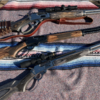Thanks all. Things to do:
1. Get a Lyman 457193SC bullet mold.
2. Get the Lyman manual.
3. Get some of the SW Buffalo Rifle propellent!
4. Call/write Hogden.
Thing is that I have a stash of RL7, H4198 and IMR4198 and plenty enough of Unique and Universal. And I like the twins (H/I 4198). I also have 400 MBC coated Buffalo #1 coming to augment my 200 reaming (not coated) and I have somewhere around 600 405 Laser Cast. So I need to use some of this up before getting too far adventurous in other directions. Oh, quite a bit of Trail Boss too, enough to keep me going until they bring it back (please!).
The rifle I am loading for principally, Ruger-Marlin GBL:
View attachment 1117959
And it's mates, missing is the cantankerous JM Cowboy:
View attachment 1117960
Too cold and windy today to shoot and got some family visiting on the agenda but I plan to work on up to 34 grains, maybe 35, of H4198 to sneak up on 1500 fps. Since 32.0 grains is giving me 1430 fps average or about that, I could just call it good with that because any pig or deer in the lower 48 I am pretty sure can be killed plenty dead with a 405 grain bullet and MV of 1430 out to a good 150 plus yards. Why cap my velocity at 1500 fps? Well, I do not like to needlessly abuse my rifle and my shoulder, internet wisdom seems to indicate leading might begin thereabout and simply, it is enough to do the job.




